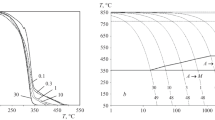Features of the microstructure formation in steel 30Cr2MnSiNi2WMo (VL-1) are studied with various heat treatment regimes: stepwise quenching at temperature below Ms (quenching and partitioning), and isothermal quenching for bainite. It is shown that the calculated optimum temperature of stepwise quenching does not provide the predicted amount of stable retained austenite in the test steel microstructure. Mechanical properties of steel 30Cr2MnSiNi2WMo after implementation of stepwise and isothermal quenching are determined. It is established that after isothermal heat treatment the steel studied exhibits reduced viscoplastic properties compared with a condition after bulk hardening and tempering.






Similar content being viewed by others
References
Automotive Steels. Design, Metallurgy, Processing and Applications (Ed. by R. Rana, S. B. Singh) Woodhead Publishing, Duxford, UK (2016).
F. C. Campbell, Manufacturing Technology for Aerospace Structural Materials, Elsevier Ltd., UK (2006).
N. V. Koptseva, Yu. Yu. Efimova, M. P. Baryshnikov, and O. A. Nikitenko, “Formation of structure and mechanical properties of carbon structural steel during nanostructuring by equal-channel angular extrusion,” Deform. Razrush. Mater, No. 7, 11–16 (2011).
H. Bhadeshia and R. Honeycombe, Steels: Microstructure and Properties, Elsevier Ltd., UK (2017).
D. V. Prosvirnin, M. D. Larionov, S. V. Pivovarchik, and A. G. Kolmakov, “Structural features and strength properties of TRIP/TWIP steels,” Perspekt. Materialy, No. 9, 5–18 (2020).
N. K. Tewary, S. K. Ghosh, D. Chakrabarti, and S. Chatterjee, “Deformation behaviour of a low carbon high Mn TWIP/ TRIP steel,” Mater. Sci. and Techn., 35, No. 12, 1483–1496 (2019).
Materials, Design and Manufacturing for Lightweight Vehicles, Ed. by P. K. Mallick, Woodhead Publishing, Duxford, UK (2010).
M. V. Maisuradze and M. A. Ryzhkov, “Thermal stabilization of austenite during stepwise hardening of steel for automobile building,” Metallurg, No. 4, 38047 (2018).
M. V. Maisuradze, Yu. V. Yudin, and A. A. Kuklina, “Increase in impact strength with formation of a bainitic structure in highstrength steel HY-TUF,” Metallurg, No. 8, 69–76 (2019).
J. G. Speer, F. C. R. Assunção, D. K. Matlock, and D. V. Edmonds, “The “Quenching and Partitioning” process: background and recent progress,” Materials Research, 8, No. 4, 417–423 (2005).
A. Yu. Kaletin, Yu. V. Kaletina, and M. A. Ryzhkov, “Carbide0free bainite in low-carbon structural steels,” Pis’ma o Materialakh, No. 3, 249–253 (2020).
Yu. N. Simonoiv, D. O. Panov, M. Yu. Simonov, V. P. Vylezhnev, and A. S. Ivanov, “2 Principles of steel chemical composition structuring in order to obtain a structure of low- carbide-free bainite with slow cooling,” MiTOM, No. 7(721), 20–28 (2015).
A. Yu. Kaletin, A. G. Ryzhkov, and Yu. V. Kaletina, “Enhancement of impact toughness of structural steels upon formation of carbide free bainite,” Physics of Metals and Metallography, 116, No. 1, 109–114 (2015).
J. Meng, F. Feng, Q. Zhou, L. Zhao, F. Zhang, and L. Qian, “Effects of austempering temperature on strength, ductility and toughness of low-C high-Al/Si carbide-free bainitic steel,” J. of Mater. Eng. and Performance, 24, 3068–3076 (2015).
F. G. Caballero, H. Roelofs, S. Hasler, C. Capdevila, J. Chao, J. Cornide, and C. Garcia-Mateo, “Influence of bainite morphology on impact toughness of continuously cooled cementite free bainitic steels,” Mater. Sci. and Techn., 28, 95–102 (2012).
M. V. Maisuradze and M. A. Ryzhkov, “Microstructure and mechanical properties of high strength alloyed steel for aerospace application,” Solid State Phenomena, 284, 351–356 (2018).
Aircraft Materials, Vol. 1. Structural Steels (A. T. Tumanov, editor), ONTI, Moscow (1975).
Phase Transformations in Steels, Ed. by E. Pereloma and D. V. Edmonds, Woodhead Publishing, Duxford, UK (2012).
Z. Zhao, C. Liu, Y. Liu, and D. O. Northwood, “A new empirical formula for the bainite upper temperature limit of steel,” J. of Mater. Sci., 36, 5045–5056 (2001).
K. W. Andrews, “Empirical formulae for the calculation of some transformation temperatures,” J. of the Iron and Steel Institute, 203, 721–727 (1965).
Acknowledgement
Work was conducted with financial support of the Russian Federation Government statement No. 2011, contract No. 02.A03.21.0006 within the scope a state assignment of the RF Ministry of Education and Science, project No. 11.1465.2014/K.
Author information
Authors and Affiliations
Corresponding author
Additional information
Translated from Metallurg, Vol. 65, No. 9, pp. 67–76, September, 2021. Russian DOI: 00260827_2021_09_67.
Rights and permissions
About this article
Cite this article
Maisuradze, M.V., Yudin, Y.V., Kuklina, A.A. et al. Formation of Microstructure and Properties During Isothermal Treatment of Aircraft Building Steel. Metallurgist 65, 1008–1019 (2022). https://doi.org/10.1007/s11015-022-01241-1
Received:
Published:
Issue Date:
DOI: https://doi.org/10.1007/s11015-022-01241-1




